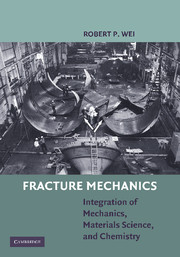Book contents
- Frontmatter
- Contents
- Preface
- Acknowledgments
- 1 Introduction
- 2 Physical Basis of Fracture Mechanics
- 3 Stress Analysis of Cracks
- 4 Experimental Determination of Fracture Toughness
- 5 Fracture Considerations for Design (Safety)
- 6 Subcritical Crack Growth: Creep-Controlled Crack Growth
- 7 Subcritical Crack Growth: Stress Corrosion Cracking and Fatigue Crack Growth (Phenomenology)
- 8 Subcritical Crack Growth: Environmentally Enhanced Crack Growth under Sustained Loads (or Stress Corrosion Cracking)
- 9 Subcritical Crack Growth: Environmentally Assisted Fatigue Crack Growth (or Corrosion Fatigue)
- 10 Science-Based Probability Modeling and Life Cycle Engineering and Management
- APPENDIX: Publications by R. P. Wei and Colleagues
Preface
Published online by Cambridge University Press: 05 June 2012
- Frontmatter
- Contents
- Preface
- Acknowledgments
- 1 Introduction
- 2 Physical Basis of Fracture Mechanics
- 3 Stress Analysis of Cracks
- 4 Experimental Determination of Fracture Toughness
- 5 Fracture Considerations for Design (Safety)
- 6 Subcritical Crack Growth: Creep-Controlled Crack Growth
- 7 Subcritical Crack Growth: Stress Corrosion Cracking and Fatigue Crack Growth (Phenomenology)
- 8 Subcritical Crack Growth: Environmentally Enhanced Crack Growth under Sustained Loads (or Stress Corrosion Cracking)
- 9 Subcritical Crack Growth: Environmentally Assisted Fatigue Crack Growth (or Corrosion Fatigue)
- 10 Science-Based Probability Modeling and Life Cycle Engineering and Management
- APPENDIX: Publications by R. P. Wei and Colleagues
Summary
Engineering Fracture Mechanics, as a recognized branch of engineering mechanics, had its beginning in the late 1940s and early 1950s, and experienced major growth through the next three decades. The initial efforts were driven primarily by naval and aerospace interests. By the end of the 1980s, most of the readily tractable mechanics problems had been solved, and computational methods have become the norm in solving practical problems in fracture/structural integrity. On the lifing (“slow” crack growth) side, the predominant emphasis has been on empirical characterization and usage of data for life prediction and reliability assessments.
In reality, fracture and “slow” crack growth reflect the response of a material (i.e., its microstructure) to the conjoint actions of mechanical and chemical driving forces, and are affected by temperature. The need for quantitative understanding and modeling of the influences of chemical and thermal environments and of microstructure (i.e., in terms of the key internal and external variables), and for their incorporation into design, along with their probabilistic implications, began to be recognized in the mid-1960s.
With support from AFOSR, ALCOA, DARPA, DOE (Basic Energy Sciences), FAA, NSF, ONR, and others, from 1966 to 2008, the group at Lehigh University undertook integrative research that combined fracture mechanics, surface and electrochemistry, materials science, and probability and statistics to address a range of fracture safety and durability issues on aluminum, ferrous, nickel, and titanium alloys and on ceramics.
- Type
- Chapter
- Information
- Fracture MechanicsIntegration of Mechanics, Materials Science and Chemistry, pp. xiii - xivPublisher: Cambridge University PressPrint publication year: 2010



